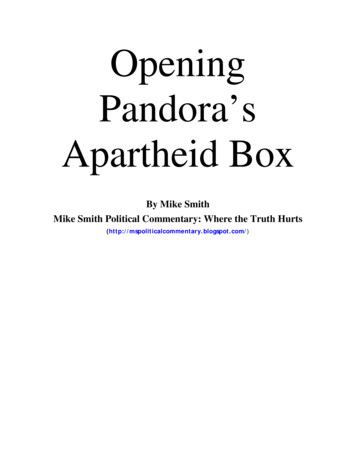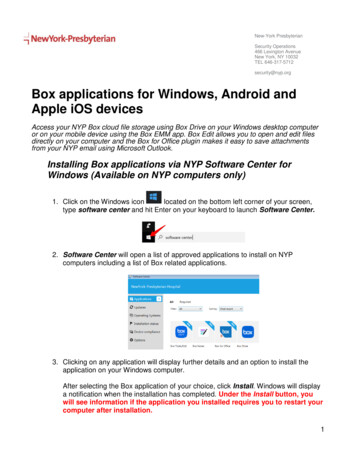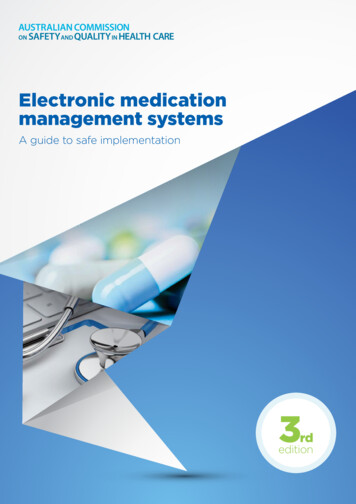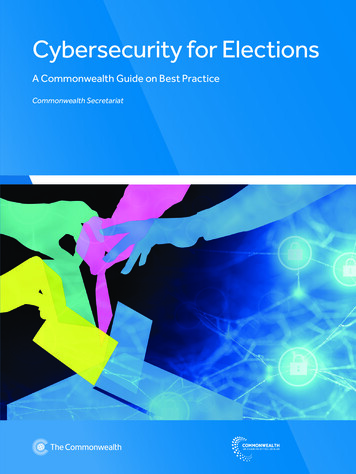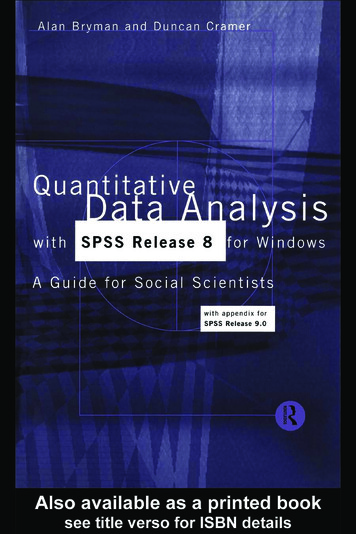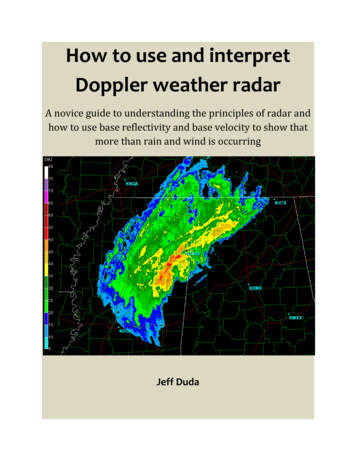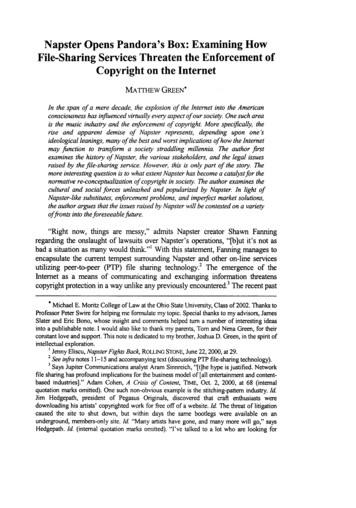
Transcription
Napster Opens Pandora's Box: Examining HowFile-Sharing Services Threaten the Enforcement ofCopyright on the InternetMATI'HEW GREEN*In the span of a mere decade, the explosion of the Internet into the Americanconsciousness has influenced virtually every aspect of our society. One such areais the music industry and the enforcement of copyright. More specifically, therise and apparent demise of Napster represents, depending upon one'sideologicalleanings,many of the best and worst implications of how the Internetmay function to transform a society straddling millennia. The author firstexamines the history of Napster, the various stakeholders, and the legal issuesraised by the file-sharing service. However, this is only part of the story. Themore interestingquestion is to what extent Napsterhas become a catalystfor thenormative re-conceptualizationof copyright in society. The author examines thecultural and social forces unleashed and popularized by Napster. In light ofNapster-like substitutes, enforcement problems, and imperfect market solutions,the authorargues that the issues raisedby Napster will be contested on a varietyoffronts into theforeseeablefuture."Right now, things are messy," admits Napster creator Shawn Fanningregarding the onslaught of lawsuits over Napster's operations, "[b]ut it's not asbad a situation as many would think."' With this statement, Fanning manages toencapsulate the current tempest surrounding Napster and other on-line servicesutilizing peer-to-peer (PTP) file sharing technology.2 The emergence of theInternet as a means of communicating and exchanging information threatenscopyright protection in a way unlike any previously encountered. The recent past*Michael E. Moritz College of Law at the Ohio State University, Class of 2002. Thanks toProfessor Peter Swire for helping me formulate my topic. Special thanks to my advisors, JamesSlater and Eric Bono, whose insight and comments helped turn a number of interesting ideasinto a publishable note. I would also like to thank my parents, Tom and Nena Green, for theirconstant love and support. This note is dedicated to my brother, Joshua D. Green, in the spirit ofintellectual exploration.Jenny Eliscu, NapsterFights Back, ROLLING STONE, June 22, 2000, at 29.See infra notes 11-15 and accompanying text (discussing PTP file-sharing technology).3Says Jupiter Communications analyst Aram Sinnreich, "[t]he hype is justified. Networkfile sharing has profound implications for the business model of [all entertainment and contentbased industries]." Adam Cohen, A Crisis of Content, TIME, Oct. 2, 2000, at 68 (internalquotation marks omitted). One such non-obvious example is the stitching-pattem industry. IdJim Hedgepath, president of Pegasus Originals, discovered that craft enthusiasts weredownloading his artists' copyrighted work for free off of a website. Id. The threat of litigationcaused the site to shut down, but within days the same bootlegs were available on anunderground, members-only site. Id. "Many artists have gone, and many more will go," saysHedgepath. Id. (internal quotation marks omitted). "I've talked to a lot who are looking for
OHIOSTATE LA WJOURNAL[Vol. 63:799has witnessed numerous lawsuits as the music industry, amongst others,scrambles to protect the commercial value of their copyrights. 4 But Fanning'scomment also betrays the hope of some that there is a light at the end of thetunnel. While the record companies view Napster and its progeny as the newmenace on the horizon, others consider them a valuable tool not only to transforma music industry ripe for overhaul but also to effect a fundamental change in howcopyrights are enforced on the Internet.Part I of this note will focus on the background and technology of Napster:what it does and how it works. Part II will detail how the battle lines have beendrawn, what the various interests of the different stakeholders are, and whatarguments are being made both for and against Napster's legality.Part III will examine the application of the current law to Napster. This partwill specifically focus on various safe harbor provisions of the Digital MillenniumCopyright Act (DCMA), the fair-use doctrine, and the substantial non-infringinguse doctrine, as espoused in Sony Corp. v. Universal City Studios, Inc.5 Analysiswill show that, in accord with the decisions of the Northern District of California 6and the Ninth Circuit,7 Napster is engaging in copyright infringement within thecurrent meaning of the law. This part will also briefly examine the likely reach ofan anti-Napster precedent.Part IV will explore my thesis that, regardless of the legal fate of Napster, theforces unleashed by Napster as a social phenomenon still threaten the musicindustry's enforcement of copyright on the Internet. First, I will examine threephilosophies underlying and propelling Napster's meteoric ascension topopularity. Second, this part will discuss alternative PTP file sharing services andthe various barriers to enforcement they pose. Third, potential market-basedsolutions to the enforcement problems will be discussed.It is my contention that, due primarily to two core reasons-thepopularization of more progressive and radical philosophies catalyzed by Napsterand the enforcement issues posed by Napster-like substitutes-any marketsolution will be an imperfect one. As a result of these factors, the foreseeablefuture will witness an interaction of legal, philosophical, and economical forces asthe music industry attempts to maintain the commercial value of its copyrights onthe Internet. I propose that the ultimate resolution of these issues will dependsomething else to do." Id. (internal quotation marks omitted).4See, e.g., UMG Recordings, Inc. v. MP3.com, Inc., 92 F. Supp. 2d 349, 350 (S.D.N.Y.2000); Recording Indus. Ass'n of Am. v. Diamond Multimedia Sys., Inc., 29 F. Supp. 2d 624,625 (C.D. Cal. 1998).5464 U.S. 417 (1984).6 A & M Records, Inc. v. Napster, Inc., 114 F. Supp. 2d 896 (N.D. Cal.2000) [hereinafterNapster I].7A & M Records, Inc. v. Napster, Inc., 239 F.3d 1004 (9th Cir. 2001) [hereinafter Napster
NAPSTER OPENS PANDORA'S BOX2002]upon the extent to which Napster's rise in popularity is truly indicative of anormative re-conceptualization of the proper role of copyright in music andsociety at large.I. HISTORY OF NAPSTER, MP3, AND PTP FILE-SHARINGNapster began as the brain child of then nineteen-year-old Shawn Fanning.8The Napster program was originally a way for Fanning to trade music in the MP3format with friends located throughout the country. Fanning and his friends werehaving trouble finding files they wanted, and the idea was to create a way forpeople to search for files and talk to each other.9 The program went up inSeptember 1999, and struck a resonant chord with music fans, as the number ofusers began to double every five to six weeks. Napster facilitates the trading of individual songs in the MP3 format.' Acommon misconception is that when someone downloads a song, the source ofthat song is Napster itself. However, Napster in its most basic form is a searchingand indexing program. Users download a program called MusicShare from theNapster website, which allows them to interact with Napster's server-sidesoftware. When each individual user logs in to Napster with the use of apassword, the MusicShare software reads the names of MP3 files that the user hasmade available to others. The Napster software then compiles, in real-time, a listof all available songs from all users who are currently logged into the Napstersystem.12 Napster next performs a search function whereby users enter a desired8 Steven Levy, The Noisy War Over Napster, NEWSWEEK, June 5, 2000, at 49.The nameNapster was a childhood nickname of Fanning's. Id. at 50. As a freshman at NortheasternUniversity in Boston, Fanning developed the Napster software in his dorm room in January,1999. Rob Sheffield, The Most DangerousMan in the Music Biz, ROLLING2000, at 42.9 Levy, supraSTONE,July 6-20,note 8, at 50.1 Id." MP3 technology was first created by the Motion Picture Experts Group in the early1980s as the audio portion of the MPEG- I audiovisual format. A &MRecords, Inc. v. Napster,Inc., No. C 99-05183 MHP, 2000 U.S. Dist. LEXIS 6243, at *2 n.I (N.D. Cal. May 5, 2000)[hereinafter Napster 11]. MP3 files reproduce nearly CD-quality sound in a compressed format.Id. at *3. The technology essentially allows people to convert the information stored on a CD,which is quite large and unwieldy, into a format which can be quickly and efficiently uploadedand downloaded on the Intemet. Recording Indus. Ass'n of Am. v. Diamond Multimedia Sys.,Inc., 180 F.3d 1072, 1073-74 (9th Cir. 1999) (discussing MP3 technology).Consumers can acquire MP3 files in two ways. Napster 1, 114 F. Supp. 2d at 901. The firstis to download recordings that have already been converted into the MP3 format. Id. Thesecond is to utilize "ripping" software which copies an audio CD directly onto a computer harddrive and converts the CD's music into MP3 format. Id.2 In other words, at any given moment, exactly what songs are available is dependentupon who is logged in and what songs they have available on their own computer.
OHIO STATE LA WJOURNAL[Vol. 63:799song title or artist, click on the "Find It" button, and view a list of files responsivea file, the user simply highlights it and clicksto the search request. To download13button.Songs"Selectedthe "GetThis process is what is meant by peer-to-peer ("PTP") file-sharing. When auser clicks on the name of a file to download it, the Napster server communicateswith the requesting and host users' MusicShare browser software to facilitate aconnection and initiate the file download. 14 In other words, Napster merelyconnects two computers. The requesting user downloads the file directly from thehost user's computer-the file is not routed through the Napster server at all. 5From its humble beginnings, Napster had attracted more new customers inless time than any other online service in history.16 At the height of its popularityin early February 2001, the service had 80 million registered users. 17 Forcomparison, Yahoo's visitor roster at the time averaged only 54 million permonth. 8 By mid-year 2000, approximately 10,000 music files were shared persecond using Napster, and 100 users attempted to connect to the system everysecond.' 9 As of early 2001, approximately 1.6 million users were online at anyone time.20 It is estimated that 2 billion songs were downloaded using Napster inJanuary 2001, up from 1.4 billion in September 2000, when the research firm222Webnoize began its measurements. ' Now, Napster is a for-profit corporationthat plans to cash in on its wide-spread popularity. Napster, Inc.'s market value,measured in part by the size of its user base, was between 60 and 80 milliondollars in mid-year 2000.23 Further, while it is extremely difficult to predict thefuture of Napster 24-- or even how long it will be in existence-the company wasstill alive in 2002 and had begun testing a new pay service.25" Napster 111, 2000 U.S. Dist. LEXIS 6243, at *3-*4.14/d.5Morning Edition: Three-Judge PanelHears Arguments from Both Sides in the NapsterCase (NPR radio broadcast, Oct. 3, 2000).16James32.Harding, Music Labels Go Back to School, FINANCIAL TIMES, Jan. 31, 2001, at17 JeffersonGraham, A Slimmed-Down Napster Gets Back Online; Trial Run is Heavy onLittle-Known Artists, USA TODAY, Jan. 10, 2002, at D1.18Jefferson Graham, Napster Moving Toward Monthly Fee: Song-Swapping ServiceCouldSet the Tonefor Internet Music Sales, USA TODAY, Jan. 30, 2001, at Al.9Napsterl, 114 F. Supp. 2d 896, 902 (N.D. Cal. 2000).20 German Media Firm Says Napster Will Charge Fees, ST. LOUIS POST-DISPATCH, Jan.31, 2001, atC7.21Graham, supra note 18, at Al.2 Levy, supra note 8, at 50 (notingthat the original idea to form Napster into a businessfirst came from Fanning's uncle).23 Napsterl, 114 F. Supp. 2d at 902.24Napster went off-line in July of 2001, and as of January 2002, the five major recordlabels were still suing Napster for copyright infringement. However, at this time, the new CEO
2002]NAPSTER OPENS PANDORA'S BOXII. STAKEHOLDERS AND SUMMARY OF THE NAPSTER DEBATEOne large contingent of people raising their voices against Napster 6 are theartists and record labels themselves. A long list of artists have spoken out againstthe service, including Don Henley, Garth Brooks, Art Alexakis of Everclear,Elton John, and Puff Daddy.2 7 Metallica and Dr. Dre were the first recordingartists to actually take legal action.2 8 The concerns of recording artists involve theloss not only of royalty payments2 9 but also of artistic control over their ownmusic. However, there has been a small group that have spoken up in support ofNapster.3' In addition, some artists have at least tried to utilize the new PTP filesharing32 technology in promotions, often with little support from their recordlabels.of Napster, Konrad Hilbers, was still trying to both settle these cases and persuade the labels tolicensetheir music to the new Napster. Graham, supra note 17, at D1.25Napster announced, on January 9, 2002, that it had begun testing a new pay version ofits music-swapping service with 20,000 selected users. Company officials said they expectedthe new service to be fully operational by April 2002, and that the price for the service would bebetween five dollars and ten dollars. Napster Inc.: Music-Swapping Service Is Testing New PayVersion, WALL ST. J., Jan. 10, 2002, at B11.26As stated previously, see supra notes 24-25 and accompanying text, the quicklyevolving nature of Napster makes it an extremely difficult topic to keep abreast of. In thediscussion that follows, therefore, any references to Napster are generally meant to apply to theolder, free version as opposed to the new, pay service unless indicated. Further, much of thediscussion which follows is also relevant to other file-sharing services-the so-called Napstersubstitutes, see infra Part IV.B,-and should be deemed to apply where relevant.27Eliscu, supra note 1,at 29.2 In early April 2000, the rock group Metallica were the first recording artists to file suitagainst Napster for copyright infiingement and racketeering, and they included as defendantsthree universities where the Napster program was popular with students and infringing activitiesoccurred. Weekend Edition Sunday: Napster: Software Company Being Sued by Several Artistsand Record Companiesfor Copyright Infingement (NPR radio broadcast, Apr. 23, 2000)[hereinafter Metallica NPR Broadcast]. Dr. Dre filed his lawsuit on April 25, 2000. Eliscu,supra note 1, at 29.29 "What [Napster is] doing is straight-up bullshit, and I'm going to fight it to the death,"says Dr. Dre. Eliscu, supra note 1,at 29 (internal quotation marks omitted). "Napster is takingfood out of my kids' mouths. I've always dreamed about making a living at something that Ilove to30 do. And they're destroying my dream." Id. (internal quotation marks omitted).Metallica drummer Lars Ulrich says the band has no problem with people recording andtrading live performances so long as nobody makes any profit. Metallica NPR Broadcast, supranote 28. Their lawsuit was prompted because "[t]he bottom line is it's our music and ourmasters [i.e., the final version of songs that appear on recorded albums], and we control those.We have the right to make the decisions about who we make them available to." Id.3 Says Public Enemy's Chuck D: "The only ones screaming about this are those who haddominance in the prior system." Eliscu, supra note 1,at 29 (internal quotation marks omitted).32In what would have been perhaps the most daring online music promotion ever, thegroup Offspring planned to release their entire album, Conspiracy of One, for free in MP3
OHIO STATE LAWJOURNAL[Vol. 63:799Looking outside the music industry, a large and powerful coalition ofstakeholders have also rallied behind the record companies' suit against Napster.These include the Motion Picture Association of America, publishers, mediaphotographers, graphic artists, digital software people, the Music ProducersGuild, and even the National Basketball Association and Major LeagueBaseball.33 All of these groups signed an anti-Napster brief, their interest being toensure that copyright laws carry over from the physical world to the Internet.34Allied with these groups is the Business Software Alliance (BSA), a trade grouprepresenting such software manufactures as Microsoft and Adobe, whichsubmitted its own brief to the Ninth Circuit Court of Appeals in the Napsterlitigation. BSA's concern is that the negative publicity being generated byNapster may overshadow the legitimate uses of PIT file-sharing technology,around which many BSA members are hoping to build business.3"By contrast, however, there also exist many groups aligned in favor ofNapster. One group includes companies that make computer hardware,telecommunications equipment, and consumer electronics (in other words, thosethat stand to make money derivatively from the increased and continuedpopularity of PTP file-sharing).36 These companies make the same argument as agroup of law professors who filed a pro-Napster brief in the Ninth Circuitlitigation: that copyright law should not be used to ban new technologies that havelegitimate purposes.3 7 Another pro-Napster ally is the conservative activist groupthe Eagle Forum. It fears that an injunction against Napster could set a precedentthat would allow companies to control or prevent the dissemination ofinformation about their products.3 8format several weeks before its release in record stores. Jenny Eliscu, The Offspring Go Offline,ROLLING STONE, Nov. 9, 2000, at 33. After Sony Music, parent company of the band'sColumbia Records recording label, and the band threatened each other with lawsuits, Offspringagreed to release only a single, "Original Prankster," as a free MP3 file on more than 200websites. Id. The Offspring's gambit would have been a direct challenge to the music industry'sposition that the availability of free MP3s will hurt record sales. Similarly "[i]n March 1999,Tom Petty removed a free download of his single 'Free Girl Now' from MP3.com after onlytwo days33 when his label, Warner Brothers, expressed concerns." Id. at 34.Morning Edition: Napster Case Draws Support from Both Sides of Copyright Issue(NPR radio broadcast, Oct. 2, 2000) [hereinafter NapsterDraws Support].34 d. ("[All these groups will] suffer irreparable harm," says Jack Valenti, president of theMotion Picture Association of America, "if the court allows users of Napster-like systems tofreely3 5copy books, photographs and broadcasts of ball games.").id.36id.7 Id. This is similar to the argument that the current Napster suit parallels the suit broughtby the movie industry against Sony in the early 1980s over the introduction of Sony's BetamaxVCR. See infra Part III.B.38 Napster Draws Support, supra note 33. Phyllis Schlafly, president of the EagleForum,gives the example of Novartis Pharmaceuticals, the company that owns the trademark, and
2002]NAPSTER OPENS PANDORA'S BOXAnother group reiterating the concerns expressed by the Eagle Forum is theDigital Media Association, or DiMA, a trade group representing Internetcompanies that provide audio and video content. While neither pro- nor antiNapster, DiMA believes the decision by Judge Patel, granting the temporaryinjunction against Napster,3 9 erroneously puts the burden onNapster to prevent itsusers from infringing copyright use. Jonathan Potter, President of DiMAperceives this decision as sweeping away the protection of the Digital MillenniumCopyright Act (DMCA),a federal law designed to protect Internet service40providers from liability.The legal position of the music industry boils down to the simple contentionthat Napster facilitates stealing. Bringing together people who exchange almostCD-quality music for free means lower sales for all artists, which translates intoless revenue for record companies and threatens the livelihood of the artiststhemselves. 4 1 Napster counters this contention with the argument that it exposeslisteners to new music, in a sense being akin to a new kind of radio that actuallypromotes music sales. 42 Further, Napster contends that its users are engaging inthe noncommercial trading of music files for personal use.43 Therefore, as thecopyrights on much of the information about, the drug Ritalin. Id. Her concern is that thecompany, by virtue of their copyrights, could shut down all search engines that lead people tocriticismsof Ritalin and alternate remedies. Id.39See Napster I, 114 F. Supp. 2d 896, 927 (N.D. Cal. 2000).40 Napster Draws Support,supra note 33.The provider of the service doesn't know everything the service is being used for. Weknow what the service is being marketed for, we know how we're advertising it, but wedon't know how every consumer is using it, and we don't want to have a responsibility forpolicing our consumers.Id. (internal quotation marks omitted); see also infra Part HI.A (discussing the DMCA).4' Fred Goodman, The Future is Now: How the Internet Is Reshaping the Record Industry,ROLLINGSTONE, July 6-20, 2000, at 41.421Id. Says John Perry Barlow-former lyricist for the Grateful Dead, co-founder and vicechairman of the Electronic Frontier Foundation, and associate professor at Harvard LawSchool's Berkman Center for Internet and Society: "If people are selling songs that are mywork and collecting the proceeds, I think that's theft. If people are distributing my work, asthey are on Napster, I don't regard that as theft, I regard it as advertising." Id. at 45 (internalquotation marks omitted). Adds Don Rose, the founder and president of Rykodisc:Remember when the RIAA went after home taping in the Seventies? . They had asticker. and a slogan [that read]HOME TAPING IS KILLINGMusic. Well, it didn't. Andremember how videotapes were going to kill film? Before that, records were going to killlive performances. In each case the opposite turned out to be true. You've got to take ahistoric perspective. Napster is a new technology, and it's freaking out the status quo.Id. at 45 (internal quotation marks omitted).43 It is not seriously alleged that Napster users receive monetary compensationin exchangefor making MP3 files available to others for downloading. Napster1, 114 F. Supp. 2d at 912.
OHIO STATE LA WJOURNAL[Vol. 63:799individual users themselves are not engaging in copyright infringement, Napsterargues it cannot be "secondarilyliable for users' nonactionable exchange of' 44copyrighted musical recordings.As might be said, though, the proof is in the pudding. Napster proponents citeseveral statistics, studies, and examples of its benign impact on record sales.45While this might be the case, the more compelling studies (and common sense)belie the fact that, in the end, access to free music will ultimately hurt recordsales.46 Whereas before consumers had the simple choice of buying or not buyingmusic, now they have the option of not buying and still owning the music.Furthermore, the proliferation of portable MP3 players and CD burners allowpeople to take the music they downloaded at no cost and use it as freely as if they44Napster I 239 F.3d 1004, 1024 (9th Cir. 2001).41For example, three of the most popular artists in terms of trading on Napster-Eminem,'N Sync, and Britney Spears-sold record-setting numbers in 2000. Goodman, supra note 41,at 42. Record sales for the first quarter of 2000 were also up nearly 8% over the year before.Metallica NPR Broadcast, supranote 28. In addition, a study of college students who downloadmusic, conducted by the Internet research firm Webnoize, Inc., found that the majority ofstudents do not permanently store the files they download. Eliscu, supra note 1, at 29. Thissentiment is echoed by a Rolling Stone poll of some 5,000 readers, which states that only 8%believed that free music on the Interet decreased the number of CDs they purchased, while36% felt it increased purchases. RS ReadersPoll: Music and the Internet, ROLLING STONE, July6-20, 2000, at 45 [hereinafter ReadersPoll].46 Says one fourteen-year-old in Falls Church, Virginia: "I haven't purchaseda CD in quitesome time." Levy, supra note 8, at 46 (internal quotation marks omitted). Also, ForresterResearch conducted a study that in the next five years the music industry will lose 3.1 billionto Internet piracy and the increasing independence of musicians. Cohen, supra note 3, at 70.Some of the most telling studies are those focusing on college students, Napster's biggestusers. Napster 1, 114 F. Supp. 2d at 909. One such study, prepared by plaintiffs' expert witnessin the case against Napster, Dr. E. Deborah Jay, shows that 41% of college students surveyed"described [Napster's] impact on their music purchases in a way which either explicitlyindicated or suggested that Napster displaces CD sales." Id. (internal quotation marks omitted).Jay's overall conclusion was that the more music Napster users downloaded, the more likelythey were to admit that such habits reduced their music purchases. Id. Another study, preparedby Soundscan, compared sales from retail stores near university campuses to nationwideaverages. The conclusion is that "on-line file sharing has resulted in a loss of album sales withincollege markets." Id. at 909-10 (internal quotation marks omitted). The data suggests that salesin these markets were off 2.5% during the same period that overall records sales were up.Goodman, supranote 41, at 42.In addition, statistics released for the year 2000 present even more damning evidence. TheInternational Federation of the Phonographic Industry reported that worldwide music sales fellfor the first time since it began collecting data some ten years ago. Worldwide sales declined1.3% to 36.9 billion and unit sales dropped by 1.2% to 3.5 billion. Also, in the United States,the sale of CD singles, perhaps "the market most likely to be hit by the Internet," fell by 39%.David Teather, Once Bitten, Twice Shy: Napster Has Been Tamed, but the Wider Battle forOnline Music Is Only Just Beginning,THE GuARDIAN (London), May 14,2001, at 62.
2002]NAPSTER OPENS PANDORA'S BOXhad purchased it legitimately. 47 What further bothers Napster critics is theimpression among many, especially younger users, that downloading music fromNapster is not morally wrong.4 8 Many perceive Napster as fulfilling a sort ofmodem-day Robin Hood role: taking from the unscrupulous, rich recordingcompanies and giving back to the general public after years of paying exorbitantprices for CDs.49IIH. LEGAL ANALYSIS OF NAPSTERThis Part analyzes the current law as it applies to the Napster litigation. Asper the decisions of the Northern District of California and Ninth Circuit5' ingranting and upholding a preliminary injunction against Napster, respectively,current law points to the finding that Napster engaged in copyright violation. Thefollowing discussion first examines the inapplicability of the DMCA, the fair-usedoctrine, the substantial non-infringing use doctrine, and the Sony case aspotential shields to liability. Finally, the likely reach of a Napster legal precedentwill be examined.A. DigitalMillennium CopyrightActThe safe harbor provisions of the Digital Millennium Copyright Act(DMCA) are one possible argument for the legality of Napster.52 Passed in 1998,the DMCA53 addresses the liability of online service and Internet access providersfor copyright infringements occurring online. Subsection 512(a) of the DMCAThe record industry's concern about the availability of portable MP3 playerscontributing to the appeal of MP3 file piracy led to the Recording Industry Association ofAmerica (RIAA) filing suit against Diamond Multimedia Systems, Inc., makers of the Rio, aportable MP3 player, in October 1998. Recording Indus. Ass'n of Am. v. Diamond MultimediaSys., Inc., 29 F.Supp. 2d 624, 625 (C.D. Cal. 1998). On appeal, the Ninth Circuit denied theRIAA's request for an injunction and, citing the Sony case, suggested that the Rio playerconstituted fair use. Recording Indus. Ass'n of Am. v. Diamond Multimedia Sys., Inc., 180F.3d 1072, 1079 (9th Cir. 1999) ("The Rio merely makes copies in order to render portable, or'space shift,' those files that already reside on a user's hard drive.").48 "Basically they're saying our art is worthless, it's free for the taking," saysRon Stone,manager for such artists as Tracy Chapman and Bonnie Raitt. "Music used to be a collectible,now it's a disposable." Levy, supra note 8, at 52 (internal quotation marks omitted).49 The Rolling Stone poll indicates that only 25% of respondents felt it was wrong todownload an artist's music for free. Readers Poll,supra note 45, at 45. A typical response fromone Virginia teenager is that "[p]eople don't think it's anything bad. Or think about it at all."note 8, at 46 (internal quotation marks omitted).Levy,5 supra0Napsterl, 114 F.Supp. 2d at 927." Napster II,239 F.3d 1004, 1029 (9th Cir. 2001).52 17 U.S.C. § 512 (Supp. V1999).53 Digital Millennium Copyright Act of 1998, Pub. L. No. 105-304, 112 Stat. 2860.41
OHIO STATE LA WJOURNAL[Vol. 63:799exempts qualifying "service providers"5 4 from monetary liability for direct,vicarious, and contributory infringement and limits injunctive relief.5" Subsection512(a) limits liability "for infiingement of copyright by reason of the [service]provider's transmitting, routing, or providing connections for, material through asystem or network controlled or operated by or for the service provider" if fiveconditions are met.16 Napster's claim, therefore, is that § 512(a) protects its corefunction of "transmitting,routing, and providing connections for sharing of the57files its users choose.This argument falls down for several reasons. First, Napster does nottransmit, route, or provide connections "through a system or network controll
NAPSTER OPENS PANDORA'S BOX upon the extent to which Napster's rise in popularity is truly indicative of a normative re-conceptualization of the proper role of copyright in music and society at large. I. HISTORY OF NAPSTER, MP3, AND PTP FILE-SHARING Napster began as
